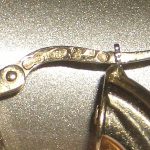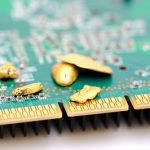An assay is any test to determine the amount and types of precious metal in a sample. They can be used to confirm if a piece of gold jewelry is 22k or 24k, to distinguish between silver and platinum, to authenticate bullion, and more. Assays are all means to the same end, but the methodology and equipment they use to find results varies widely. Here, we’ll explain a few different assays, the variables they test, and the tools they use.
Touchstone assay (AKA hand test, acid test, or scratch test)
- Tools: Touchstone (a flat, solid colored stone with a fine-grit surface – usually basalt or slate), nitric acid at different levels of concentration
- Dependent Variable: Alloyed gold is resistant to nitric acid, while pure gold is unaffected. Does the sample oxidize in the presence of nitric acid, and at what concentration?
- Methodology: The sample is scratched against the touchstone, making a light streak of metallic dust. Next, diluted nitric acid is applied to the streak. If the streak dissolves the sample is not gold. If no reaction occurs, nitric acid is applied in increasing concentrations until the correct karat rating of the gold can be determined.
X-RF assay
- Tools: Specialized X-RF machine, hooked up to a computer
- Dependent Variable: Metal emits light (fluorescence) at an energy level specific to its atomic structure when exposed to x-rays. Does the x-ray fluorescence of the sample match the known values for precious metals?
- Methodology: The sample is placed within the machine, which exposes the sample to x-rays, measures the resulting fluorescence, and creates a printable analysis of the results.
Ultrasonic assay
- Tools: Diagnostic ultrasound transducer
- Dependent Variable: Propagation consistency of ultrasonic waves within the sample. Does an ultrasonic pulse change as it passes through the sample?
- Methodology: Ultrasonic waves traveling through any medium will continue propagating in the same direction until they strike a boundary with a different material, which will cause them to reflect back to their source. The transducer transmits a pattern of ultrasonic pulses into the sample and measures the speed and intensity of the reflections. Reflections coming from inside a bullion bar, rather than the opposite surface, change the pattern and indicate either an internal void or a filling made with a different metal.
PMV assay
- Tools: Precious metal verification device
- Dependent Variable: Electrical resistivity. Does the sample’s resistivity match the known resistivity for precious metals of equal weight?
- Methodology: First, the verification device uses electromagnetic waves to measure the surface resistivity of the sample. Then it sends another wave completely through the sample to measure through-resistivity and thickness. A result falling within the range of known values confirms that the electrical resistivity of the sample matches what is expected for that metal. In addition, by checking the sample’s through-resistivity against its surface resistivity, the verifier can detect whether a sample is plated or filled.











